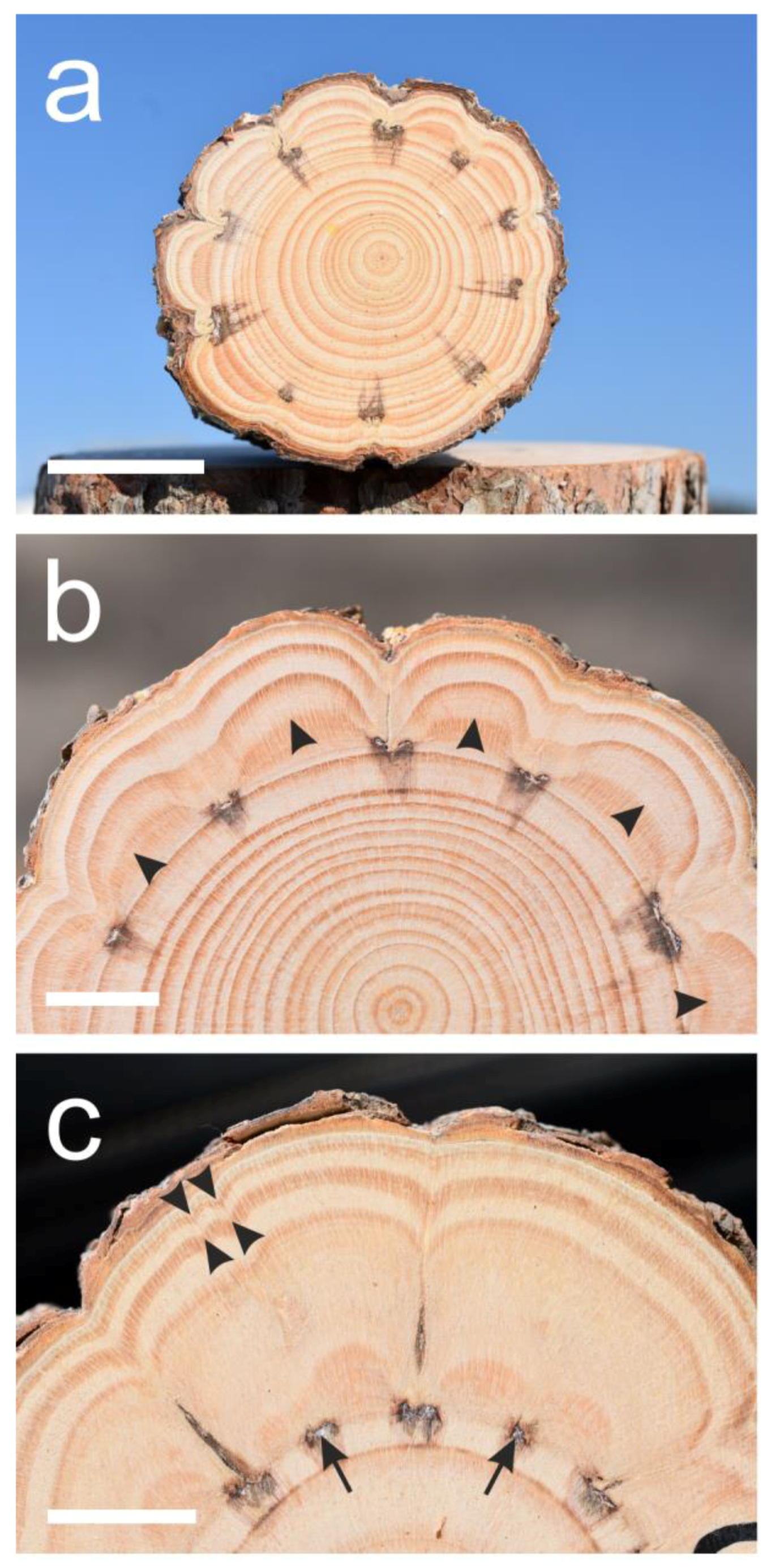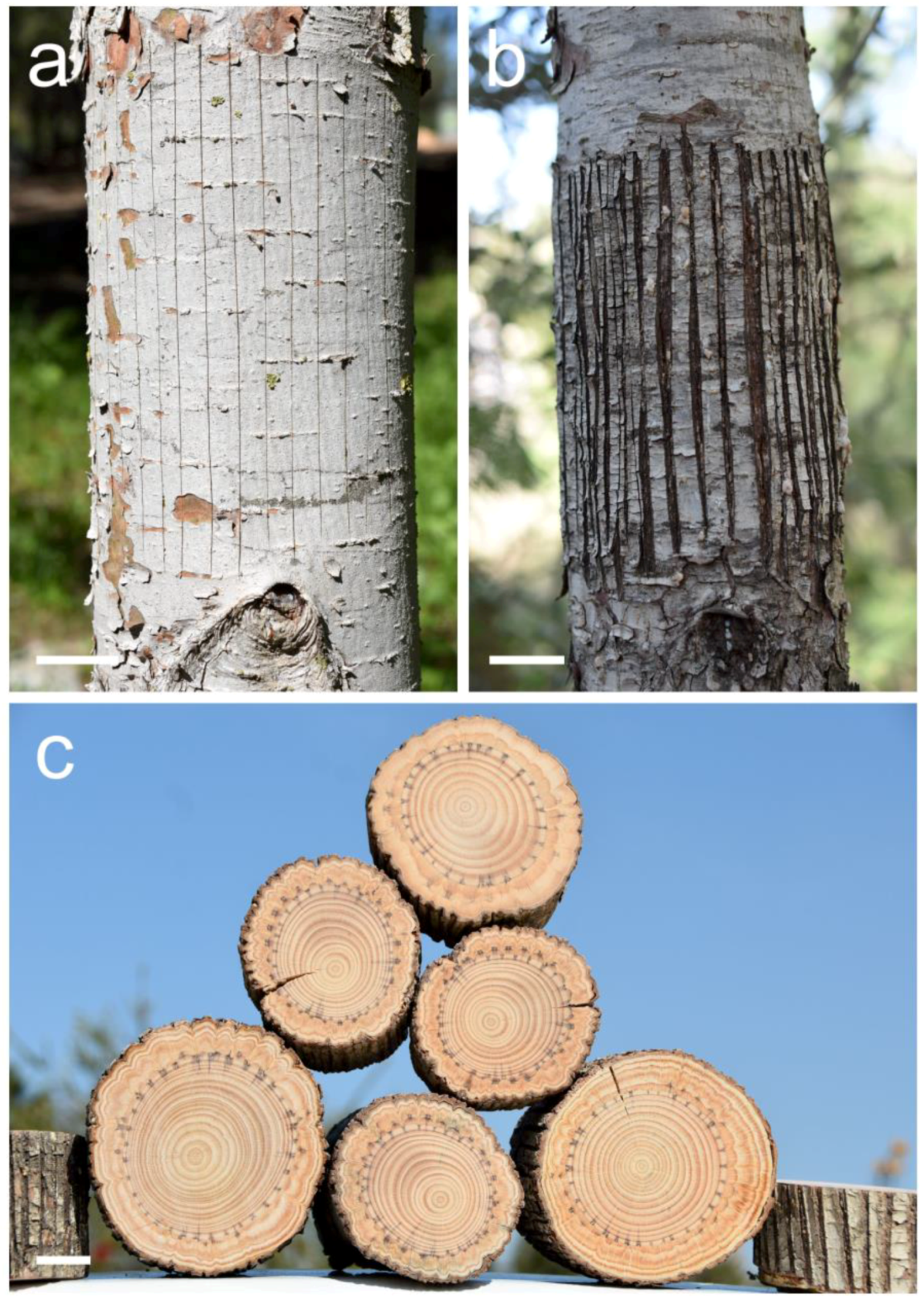Experimental Induction of Extreme Indented Growth Rings (Hazel Wood) in Pinus halepensis Miller by Wide and Long Parallel Bark and Vascular Cambium Woundings
Abstract
1. Introduction
2. Results
3. Discussion
4. Further Research
5. Materials and Methods
Author Contributions
Funding
Data Availability Statement
Acknowledgments
Conflicts of Interest
References
- Ziegler, H.; Merz, W. “Hasel” growth. Eur. J. Wood Wood Prod. 1961, 19, 1–8. [Google Scholar] [CrossRef]
- Lev-Yadun, S.; Račko, V.; Kardošová, M.; Ďurkovič, J. Indented growth-rings (hazel wood) deserve more attention. Dendrochronologia 2023, 79, 126073. [Google Scholar] [CrossRef]
- Kraler, A.; Beikircher, W.; Rofner, A. Selected characteristics of Norway spruce with indented rings (hazel growth) for violins. Pro Ligno 2017, 13, 71–77. [Google Scholar]
- Dünisch, O. Frequencies in vibrating wood—Does cell organization matter? IAWA J. 2019, 40, 124–142. [Google Scholar] [CrossRef]
- Cherubini, P. Tree-ring dating of musical instruments. Science 2021, 373, 1434–1436. [Google Scholar] [CrossRef] [PubMed]
- Cherubini, P.; Carlson, B.; Talirz, W.; Wiener, M.H. Musical string instruments: Potential and limitations of tree-ring dating and provenancing to verify their authenticity. Dendrochronologia 2022, 72, 125942. [Google Scholar] [CrossRef]
- Imamura, Y. Anatomical characteristics of decorative Sugi logs in Japanese wooden structure. In Proceedings of the XVII IUFRO World Congress Division 5, Kyoto, Japan, 6–17 September 1981. [Google Scholar]
- Lev-Yadun, S.; Aloni, R. An experimental method of inducing “hazel” wood in Pinus halepensis (Pinaceae). IAWA Bull. n.s. 1991, 12, 445–451. [Google Scholar] [CrossRef]
- Lev-Yadun, S. Wood structure and the ecology of annual growth ring formation in Pinus halepensis and Pinus brutia. In Ecology, Biogeography and Management of Pinus halepensis and Pinus brutia Forest Ecosystems in the Mediterranean Basin, 1st ed.; Ne’eman, G., Trabaud, L., Eds.; Backhuys Publishers: Leiden, The Netherlands, 2000; pp. 67–78. [Google Scholar]
- Carmi, A.; Sachs, T.; Fahn, A. The relation of ray spacing to cambial growth. New Phytol. 1972, 71, 349–353. [Google Scholar] [CrossRef]
- Lev-Yadun, S.; Aloni, R. The role of wounding in the differentiation of vascular rays. Int. J. Plant Sci. 1992, 153, 348–357. [Google Scholar] [CrossRef]
- Lev-Yadun, S. Wound effects arrest wave phenomena in the secondary xylem of Rhamnus alaternus (Rhamnaceae). IAWA J. 2001, 22, 295–300. [Google Scholar] [CrossRef]
- Noel, A.R.A. The girdled tree. Bot. Rev. 1970, 36, 162–195. [Google Scholar] [CrossRef]
- Lev-Yadun, S. Induction of near-vessellessness in Ephedra campylopoda C. A. Mey. Ann. Bot. 1994, 75, 683–687. [Google Scholar] [CrossRef]
- Swetnam, T.W. Peeled ponderosa pine trees: A record of inner bark utilization by native Americans. J. Ethnobiol. 1984, 4, 177–190. [Google Scholar]
- Stoffel, M.; Bollschweiler, M. Tree-ring analysis in natural hazards research—An overview. Nat. Hazards Earth Syst. Sci. 2008, 8, 187–202. [Google Scholar] [CrossRef]
- De Micco, V.; Zalloni, E.; Balzano, A.; Battipaglia, G. Fire influence on Pinus halepensis: Wood responses close and far from the scars. IAWA J. 2013, 34, 446–458. [Google Scholar] [CrossRef]
- Nystedt, B.; Street, N.R.; Wetterbom, A.; Zuccolo, A.; Lin, Y.-C.; Scofield, D.G.; Vezzi, F.; Delhomme, N.; Giacomello, S.; Alexeyenko, A.; et al. The Norway spruce genome sequence and conifer genome evolution. Nature 2013, 497, 579–584. [Google Scholar] [CrossRef] [PubMed]
- Warren, R.L.; Keeling, C.I.; Yuen, M.M.S.; Raymond, A.; Taylor, G.A.; Vandervalk, B.P.; Mohamadi, H.; Paulino, D.; Chiu, R.; Jackman, S.D.; et al. Improved white spruce (Picea glauca) genome assemblies and annotation of large gene families of conifer terpenoid and phenolic defense metabolism. Plant J. 2015, 83, 189–212. [Google Scholar] [CrossRef]
- Stevens, K.A.; Wegrzyn, J.L.; Zimin, A.; Puiu, D.; Crepeau, M.; Cardeno, C.; Paul, R.; Gonzalez-Ibeas, D.; Koriabine, M.; Holtz-Morris, A.E.; et al. Sequence of the sugar pine megagenome. Genetics 2016, 204, 1613–1626. [Google Scholar] [CrossRef] [PubMed]
- Zimin, A.V.; Stevens, K.A.; Crepeau, M.W.; Puiu, D.; Wegrzyn, J.L.; Yorke, J.A.; Langley, C.H.; Neale, D.B.; Salzberg, S.L. An improved assembly of the loblolly pine mega-genome using long-read single-molecule sequencing. Gigascience 2017, 6, giw016. [Google Scholar] [CrossRef]
- Neale, D.B.; Martínez-García, P.J.; De La Torre, A.R.; Montanari, S.; Wei, X.X. Tree genome sequencing: Novel insights into plant biology. Annu. Rev. Plant Biol. 2017, 68, 457–483. [Google Scholar] [CrossRef] [PubMed]
- Neale, D.B.; Wheeler, N.C. The Conifers: Genomes, Variation and Evolution; Springer: Cham, Switzerland, 2019. [Google Scholar] [CrossRef]
- Liphschitz, N.; Lev-Yadun, S.; Rosen, E.; Waisel, Y. The annual rhythm of activity of the lateral meristems (cambium and phellogen) in Pinus halepensis Mill. and Pinus pinea L. IAWA Bull. n.s. 1984, 5, 263–274. [Google Scholar] [CrossRef]




| Tree Number | Date of Wounding | Forest | Age of Wounded Sector (Years) | Date of Sampling | Type of Wounding and Number of Wounds |
|---|---|---|---|---|---|
| 1 | 17 April 2020 | Hulda | 4 | 17 May 2021 | All around (9) |
| 2 | 19 April 2020 | Ben-Shemen | 5 | 23 August 2023 | All around (10) |
| 3 | 19 April 2020 | Ben-Shemen | 8 | 30 December 2023 | Part (6) |
| 4 | 19 April 2020 | Ben-Shemen | 7 | 30 December 2023 | Part (6) |
| 5 | 19 April 2020 | Ben-Shemen | 8 | 30 December 2023 | Part (6) |
| 6 | 19 April 2020 | Ben-Shemen | 13 | 1 January 2024 | All around (12) |
| 7 | 17 April 2020 | Hulda | 13 | 11 February 2024 | All around (10) |
| 8 | 19 April 2020 | Ben-Shemen | 5 | 25 February 2024 | All around (9) |
| 9 | 19 April 2020 | Ben-Shemen | 15 | 25 February 2024 | All around (11) |
| 10 | 19 April 2020 | Ben-Shemen | 5 | 29 February 2024 | All around (9) |
Disclaimer/Publisher’s Note: The statements, opinions and data contained in all publications are solely those of the individual author(s) and contributor(s) and not of MDPI and/or the editor(s). MDPI and/or the editor(s) disclaim responsibility for any injury to people or property resulting from any ideas, methods, instructions or products referred to in the content. |
© 2024 by the authors. Licensee MDPI, Basel, Switzerland. This article is an open access article distributed under the terms and conditions of the Creative Commons Attribution (CC BY) license (https://creativecommons.org/licenses/by/4.0/).
Share and Cite
Lev-Yadun, S.; Kováč, J.; Ďurkovič, J.; Račko, V. Experimental Induction of Extreme Indented Growth Rings (Hazel Wood) in Pinus halepensis Miller by Wide and Long Parallel Bark and Vascular Cambium Woundings. Plants 2024, 13, 2265. https://doi.org/10.3390/plants13162265
Lev-Yadun S, Kováč J, Ďurkovič J, Račko V. Experimental Induction of Extreme Indented Growth Rings (Hazel Wood) in Pinus halepensis Miller by Wide and Long Parallel Bark and Vascular Cambium Woundings. Plants. 2024; 13(16):2265. https://doi.org/10.3390/plants13162265
Chicago/Turabian StyleLev-Yadun, Simcha, Ján Kováč, Jaroslav Ďurkovič, and Vladimír Račko. 2024. "Experimental Induction of Extreme Indented Growth Rings (Hazel Wood) in Pinus halepensis Miller by Wide and Long Parallel Bark and Vascular Cambium Woundings" Plants 13, no. 16: 2265. https://doi.org/10.3390/plants13162265
APA StyleLev-Yadun, S., Kováč, J., Ďurkovič, J., & Račko, V. (2024). Experimental Induction of Extreme Indented Growth Rings (Hazel Wood) in Pinus halepensis Miller by Wide and Long Parallel Bark and Vascular Cambium Woundings. Plants, 13(16), 2265. https://doi.org/10.3390/plants13162265










